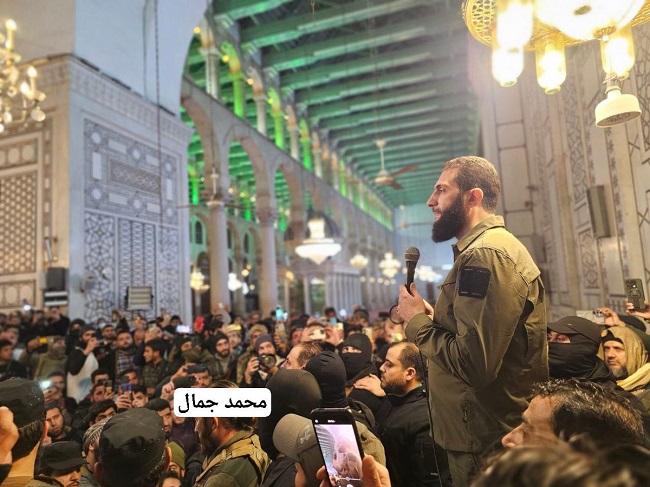
Assad has fallen and the former Qaedist Al Jolani, redeemed as a bridge-builder-statist, has triumphantly entered Damascus (pictured inside the Great Umayyad Mosque).
The regime and the Syrian Army have liquefied, after years of being artificially held up by Moscow and Tehran. A page has been turned, yet one whose contours are difficult to define. There are only two certainties at the moment.
First, the so-called Axis of Resistance has been broken. The geostrategic continuity between Tehran and Beirut is no more. A hole has been created in the middle of the Shia Crescent. And this, more than the result of rebel action, is the result of Israel's military initiatives, which have dismantled the infrastructure of Hezbollah and the Pasdaran in Lebanon and Syria (Israel is finishing the job and sending very clear messages to the new Syria in these hours). For Tehran, this is a stark loss in geopolitical terms and in terms of influence that cannot be compensated for in the short to medium term.
The second certainty: to Putin too, the end of Assad means a dry loss of influence. What will become of the bases in Tartus and Hmeimim? What will become of the outlet on the ‘warm sea’? For the time being, Russian installations on the Syrian coast are untouched. Certainly, the collapse of the regime has demonstrated the limits of Russia's political-military guarantee. With the war in Ukraine grinding away at resources, Moscow is struggling to keep up its commitments in the other chessboards, be they the Middle East or the Sahel, where in recent months the Tuareg rebellion has been putting the pro-Russian military junta in Mali on the ropes.
In contrast to Tehran, however, the end of Assad could be compensated by Moscow in the short term if efforts to open a base in Benghazi, Cyrenaica, are successful. Not to mention the good relations with the Kurds, who may soon find themselves orphaned by the US.
The rebel front probably did not expect such a rapid collapse of the regime and was not prepared for it. That is why Prime Minister Al Jalali has remained in place and the administrative structures of the state have not been touched. Then, there are the internal divisions that, once the hangover from the ‘victory’ has passed, will emerge: indeed, they are already emerging in part.
As of today, it is possible to identify the following ‘strands’ of the rebellion as more structured (obviously leaving aside the insurgents of the last hour, like our partisans on 25 April morning...). The first is the Islamist one of HTS (Hayat Tahrir al-Sham), which brings together former Qaedists and Salafists and has ruled Idlib. HTS has benefited in recent times from operational and intelligence support from Turkey, but what is the actual degree of control Ankara can exercise over HTS? We will soon find out.
The SNA (Syrian National Army), the Syrian Muslim Brotherhood, over which Erdogan has direct and official control, is a different matter. In these hours, the SNA militiamen, with the support of Turkish drones and artillery, are clashing with the Kurdish forces of the SDF (Syrian Democratic Forces) for control of the strategic town of Manbij, in the north of the country. Erdogan's goal is clear: to extend his influence to the whole of northern Syria, limiting the territorial size of the Kurdish canton as much as possible.
Speaking of Turkey, if for Putin and Tehran there has been a net loss of influence in Syria, for Erdogan, on the other hand, the gain is clear. To date, Turkey is the real winner in the Syrian civil war, but the depth of its influence depends on the financial support of Qatar. The rebel front, however, does not end there. There is, in fact, that Salafist world that is not under the HTS umbrella and that has re-emerged in recent days: a strand with traditional links to Saudi intelligence. What will Mohamed Bin Salman do, leave Syria to Turkey and Qatar and, therefore, to the ‘enemy of enemies’, the Muslim Brotherhood? If there is one thing with respect to which Saudi legitimism is irreconcilable, it is the Muslim Brotherhood's ‘electoral popularism’.
If elections were to be held in Syria tomorrow, in fact, the Brotherhood could make a splash. Then, there is the variegated localist strand including clans, tribes, gangs, whose interest is circumscribed and of an essentially economic-criminal nature, and whose aspiration is in many cases to replace the regime's structures in the smuggling of Captagon.
Finally, the Islamic State, which could raise its head again, takes advantage of the chaos and recruits new followers in the radical world who are disappointed by the institutionalisation process. It is no coincidence that last night US air strikes, which saw the use of A-10s, F-15 fighter-bombers and B-52 bombers, hit 75 IS-linked targets in the central part of the country.








.png)
